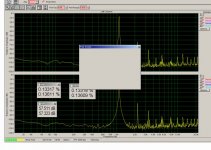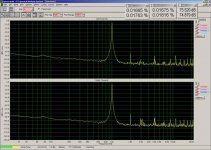I did some tests on my TDA1543 nos DAC and was kind of disappointed with the results: THD .13% for 1.2kHz tone track The same track played on the Panasonic dvd player was producing .03% of THD.
The same track played on the Panasonic dvd player was producing .03% of THD.
The I/V is passive using 2 4.7uF non-polar BG caps(super-e) and Rikens 3.3k resistors. I removed the 50k resistors for now, they should make no difference on the THD, I think.
Attached are 2 graphs showing the 1.2kHz and white noise.
The I/V is passive using 2 4.7uF non-polar BG caps(super-e) and Rikens 3.3k resistors. I removed the 50k resistors for now, they should make no difference on the THD, I think.
Attached are 2 graphs showing the 1.2kHz and white noise.
Attachments
I have been too lazy or scared to measure mine but I
but I
can definitely hear artifacts when doing a 20-20 sweep with a
test cd.
Funny though, it is still enjoyable to listen to.
I guess I must have cloth ears or the coloration the distortion adds is not as bothersome as expected....Unless that is what is
causing my perceived HF [minor] issues ..Hmmm.
..Hmmm.
Setmenu
 but I
but Ican definitely hear artifacts when doing a 20-20 sweep with a
test cd.
Funny though, it is still enjoyable to listen to.
I guess I must have cloth ears or the coloration the distortion adds is not as bothersome as expected....Unless that is what is
causing my perceived HF [minor] issues
 ..Hmmm.
..Hmmm.Setmenu

Peter Daniel said:You migh try to put a trimpot for Rref and see if you can bring distortion figure down.
I have to admit that the Riken value I'm using might not be optimal, but only one available in that range.
I've always used a trimpot for Rfef to adjust to different loads when swapping resistors. It's much more convenient than guessing which resistor I'd need to solder to bias the loads and so on... Replacing the trimpot with a resistor wouldn't affect the THD, I hope, it's something else, that may be tweaked for best value.
I don't understand, how come the datasheet shows the low THD for TDA1543 and in the real world application, it's 10 times more? It is caused by a passive I/V vs active one using amps? Too much load on the analog output of the chip? Using prototype PCB without proper grounding? Bad power supply/regulators(I use the battery board and tried the 24v regulated one, it's all the same with both)? What did I miss....?
What are the values for THD and NOise from other folks on the forum? I remember Doede's ones only: THD=.08% for 1kHz, which is still pretty big
About the i/v resistors...
I used the 1.8k before for about 2 weeks and it sounded ok, but a bit quiet and lacked bass. I put back 3.3k resistors and the sound is more dynamic and punchier, I like it this way better. I will start experimenting with an active opamp i/v stage soon, but this combo would settle for my passive one. Maybe 2.7k is a better choice, but it's almost near 3.3k anyway.
How does the TDA1543 sound with 5V anyway? I cannot test it right now but a bit curious...
Hi,
IMHO any R2R DAC does not like voltage on its output.
Passive I/V always has voltage...
But also with op amp conversion it is mediocre ( what a nice word ) technically.
I had a computer CD rom drive with 1543, with -60dB signal the distortion on spectrum analyzer looked like Armageddon .
It is comparable to TDA1540 which is 14bit.
But some folks here say it is th best !
Rich harmoniics ...
Bernhard
IMHO any R2R DAC does not like voltage on its output.
Passive I/V always has voltage...
But also with op amp conversion it is mediocre ( what a nice word ) technically.
I had a computer CD rom drive with 1543, with -60dB signal the distortion on spectrum analyzer looked like Armageddon .
It is comparable to TDA1540 which is 14bit.
But some folks here say it is th best !
Rich harmoniics ...
Bernhard
Changed/added a couple of things on my DAC and the THD is now 0.017% with SNR at 75dB. Better than my dvd player for sure!!! And way to go for any portable use too, I think  No doubt that other chips(nos dacs) may give better performance, but what other chips can be used for portable setups?
No doubt that other chips(nos dacs) may give better performance, but what other chips can be used for portable setups?
Peter Daniel was right about AN8xxx regulators. Not only do they sound better, but make a big difference in improving the specs too . Other things including output bias and fine tuning the VREF are also bring some distortion down.
. Other things including output bias and fine tuning the VREF are also bring some distortion down.
Bernard, the non-oversampling harmonics are really rich and not ARTIFICIAL... give it a try some day with proper implementation.
Here's the new results from SpectraLab for 1kHz:
Peter Daniel was right about AN8xxx regulators. Not only do they sound better, but make a big difference in improving the specs too
Bernard, the non-oversampling harmonics are really rich and not ARTIFICIAL... give it a try some day with proper implementation.
Here's the new results from SpectraLab for 1kHz:
Attachments
IpsilonSound said:
Bernard, the non-oversampling harmonics are really rich and not ARTIFICIAL... give it a try some day with proper implementation.
That's what I say.
I liked it but still prefer absence of harmonics.
Harmonics.
I realize the proper way to do is to look at graphic readouts from precision measuring tools etc.
But does/has any one here actually listened to frequency sweeps/spots to ascertain the audible effect with 'pure' tones?
I still cannot come to terms with what I consider pretty dodgy sounding test tones and the fact that the dac sounds pretty OK with music
Setmenu
I realize the proper way to do is to look at graphic readouts from precision measuring tools etc.
But does/has any one here actually listened to frequency sweeps/spots to ascertain the audible effect with 'pure' tones?
I still cannot come to terms with what I consider pretty dodgy sounding test tones and the fact that the dac sounds pretty OK with music

Setmenu
setmenu said:But does/has any one here actually listened to frequency sweeps/spots to ascertain the audible effect with 'pure' tones?
Very good idea.
I have CD players with PCMXX chips where distortion can be optimized with a pot.
In non optimal adjustment distortion of 1kHz is clearly audible.
I will unudjust the pot and measure at the point where distortion comes to my ears.
Peter Daniel said:At what frequency is that "pretty dodgy sounding test tone"?
Hi Peter
My 'scientific' test
to monitor the sound.
Using a sweep the effect is of lower frequency warbling birdies at the upper reaches of the sweep.
Using the spot frequencies, up to 14k seems ok, 16K sounds like there is another lower tone involved and once I hit 18k there does not appear to be an 18k tone anymore or it is swamped by lower frequencies tone
Same for 20K.
Obviously my sensitivity to the higher frequencies is less than the lower so their sounds are probably being masked.
The Arcam on the other hand is 'clean' until above my hearing ability.
If I remember correctly aren't the highest frequencies[nos] modulated by the sampling frequency or some such?

Cheers
Setmenu
Bernhard said:
Very good idea.
I have CD players with PCMXX chips where distortion can be optimized with a pot.
In non optimal adjustment distortion of 1kHz is clearly audible.
I will unudjust the pot and measure at the point where distortion comes to my ears.
Hi Bernhard
When you say 1k, do mean listening to a 1k test tone?
Cheers
Setmenu
setmenu said:Harmonics.
I realize the proper way to do is to look at graphic readouts from precision measuring tools etc.
The SpectraLab software is pretty accurate and can be used for precision measurements of sound equipment. The problem lies in the sound equipment, therefore, it is recommended that professional computer soundcards are used with it. Or at least, the soundcard needs to have lower distortions and better characteristics than the equipment being tested.
I measured my soundcard(Audigy1, it's more stable than later Audigy generations), and with the 1kHz test tone the THD for it was 0.003%, well below the DAC specs, so it is rather suited for this application.
About the spikes, I'm not completely sure about them 100%, they appeared more audible on the first runs of testing, when the i/v load was higher (3.3k). The THD was much higher then as well. With the load of 1.8k they are much less visible on the spectrum, therefore, the sound must be purer. And it does sound cleaner with the less load. The disadvantage of the passive i/v with less load, however, is weaker output - now it's giving 1V instead of the standard 2V of lineout from the CD. In other words, it looks more attractive to switch to the opamp i/v stage using precision fast low-noise opamps, like LM6172 or THS4082.
Any suggestions how to deal with those dodgy spikes? If they are caused by noise from the power regulators or digital signal, proper filtering can be applied, I think, to eliminate them. They are not random, in fact, and appear on 2, 3, 5, 7, 9, 11kHz and so on for 1kHz test tone... odd frequency spike ringing, except for 2kHz, of course. Are they caused by improper grounding, since I put everything on a test pcb?
Do shoot me down in flames  but with this passive IV lark,
but with this passive IV lark,
the main consideration seems to be the need for volts from our end, and the need for low impedance form the dacs point of view?
I wondered would using a low low value Iv resister followed by a Op set at a sufficiently high gain [bandwidth] be a valid approach?
No doubt this has been already covered and resulted in sound eh?
sound eh?
Cheers
Setmenu
 but with this passive IV lark,
but with this passive IV lark,the main consideration seems to be the need for volts from our end, and the need for low impedance form the dacs point of view?
I wondered would using a low low value Iv resister followed by a Op set at a sufficiently high gain [bandwidth] be a valid approach?
No doubt this has been already covered and resulted in
 sound eh?
sound eh?Cheers
Setmenu
setmenu said:
Using a sweep the effect is of lower frequency warbling birdies at the upper reaches of the sweep.
Using the spot frequencies, up to 14k seems ok, 16K sounds like there is another lower tone involved and once I hit 18k there does not appear to be an 18k tone anymore or it is swamped by lower frequencies tone.
Same for 20K.
Setmenu, it may sound disappointing to you, sorry, but i ran the 15 to 20kHz test tones thru my DAC and it sounds very good to me. I didn't hear any audible distortions like additional lower frequency tones at all, really. At 20kHz you can hardly hear any tone, it's like flying on a plane when your ears feel some pressure or something, just some high-pitch feeling instead of the sound.
There must be something else with your DAC or your amp(why not?) since it gives you what you described in your post. Try different amps, connect the phones directly to your DAC without amp, etc. etc...
if the distortions don't go away, i would revise the schematics and try different configurations, parts, and so on, until the high frequency garbage is gone. My cheap Sanyo mp3 player makes the same noises in the high frequency area, but who cares about it? I only use it for testing purposes, not for reference or listening pleasure.
IpsilonSound said:
Setmenu, it may sound disappointing to you, sorry, but i ran the 15 to 20kHz test tones thru my DAC and it sounds very good to me. I didn't hear any audible distortions like additional lower frequency tones at all, really. At 20kHz you can hardly hear any tone, it's like flying on a plane when your ears feel some pressure or something, just some high-pitch feeling instead of the sound.
There must be something else with your DAC or your amp(why not?) since it gives you what you described in your post. Try different amps, connect the phones directly to your DAC without amp, etc. etc...
if the distortions don't go away, i would revise the schematics and try different configurations, parts, and so on, until the high frequency garbage is gone. My cheap Sanyo mp3 player makes the same noises in the high frequency area, but who cares about it? I only use it for testing purposes, not for reference or listening pleasure.
Hmm all 3 of them do it, and with all the amps tested.
And I can't really connect phones directly to the dac,won't drive em!
As for layout and parts choice, yup could be [most likely] that is
to blame then.
But this thing needs to be small so choices are limited...
Still, based on the observed shortcomings it does seem to sound
nice

But I am not content, I want a better matchbox sized dac


Setmenu

setmenu said:No doubt this has been already covered and resulted insound eh?
Setmenu, with all due respect, this is gross overgeneralization. Why being so dependent on others' mishaps with active i/v stage experiments? You can find dozens of different implementations of the i/v active stages, ranging from simple to complex. For some it did result with inferior sound, but that shouldn't preclude one from trying it out for himself and rushing to decisions only after all the possibilities have been explored.
I never said the passive i/v was that bad, to me it sounds great, but I cannot implement it with the same power supply feeding both my PPA and DAC. That's Reason #1. Reason #2 - attempt to reduce the distortions and spikes visible on the spectrum, and they are clearly dependent on the load/impedeance put on the TDA1543. Therefore, properly implemented 3 channel, virtual ground, class-a, precision, extremly low noise/distortion wideband active i/v stage may be the only remedy for this? Did you check the datasheet specs for LM6171 amp?
- Status
- This old topic is closed. If you want to reopen this topic, contact a moderator using the "Report Post" button.
- Home
- Source & Line
- Digital Source
- TDA1543 test results using SpectraLab.


